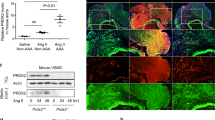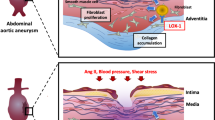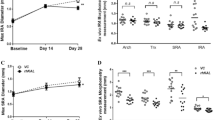Abstract
Inflammation and oxidative stress are pathogenic mediators of many diseases, but molecules that could be therapeutic targets remain elusive. Inflammation and matrix degradation in the vasculature are crucial for abdominal aortic aneurysm (AAA) formation. Cyclophilin A (CypA, encoded by Ppia) is highly expressed in vascular smooth muscle cells (VSMCs), is secreted in response to reactive oxygen species (ROS) and promotes inflammation. Using the angiotensin II (AngII)-induced AAA model in Apoe−/− mice, we show that Apoe−/−Ppia−/− mice are completely protected from AngII–induced AAA formation, in contrast to Apoe−/−Ppia+/+ mice. Apoe−/−Ppia−/− mice show decreased inflammatory cytokine expression, elastic lamina degradation and aortic expansion. These features were not altered by reconstitution of bone marrow cells from Ppia+/+ mice. Mechanistic studies showed that VSMC-derived intracellular and extracellular CypA are required for ROS generation and matrix metalloproteinase-2 activation. These data define a previously undescribed role for CypA in AAA formation and suggest CypA as a new target for treating cardiovascular disease.
This is a preview of subscription content, access via your institution
Access options
Subscribe to this journal
Receive 12 print issues and online access
$209.00 per year
only $17.42 per issue
Buy this article
- Purchase on Springer Link
- Instant access to full article PDF
Prices may be subject to local taxes which are calculated during checkout






Similar content being viewed by others
References
Kunieda, T. et al. Angiotensin II induces premature senescence of vascular smooth muscle cells and accelerates the development of atherosclerosis via a p21-dependent pathway. Circulation 114, 953–960 (2006).
Griendling, K.K. & FitzGerald, G.A. Oxidative stress and cardiovascular injury: Part II: animal and human studies. Circulation 108, 2034–2040 (2003).
Taniyama, Y. & Griendling, K.K. Reactive oxygen species in the vasculature: molecular and cellular mechanisms. Hypertension 42, 1075–1081 (2003).
Bruemmer, D. et al. Angiotensin II–accelerated atherosclerosis and aneurysm formation is attenuated in osteopontin-deficient mice. J. Clin. Invest. 112, 1318–1331 (2003).
Sun, J. et al. Mast cells promote atherosclerosis by releasing proinflammatory cytokines. Nat. Med. 13, 719–724 (2007).
Yoshimura, K. et al. Regression of abdominal aortic aneurysm by inhibition of c-Jun N-terminal kinase. Nat. Med. 11, 1330–1338 (2005).
Thomas, M. et al. Deletion of p47phox attenuates angiotensin II–induced abdominal aortic aneurysm formation in apolipoprotein E–deficient mice. Circulation 114, 404–413 (2006).
Gavazzi, G. et al. NOX1 deficiency protects from aortic dissection in response to angiotensin II. Hypertension 50, 189–196 (2007).
Thompson, R.W. & Baxter, B.T. MMP inhibition in abdominal aortic aneurysms. Ann. NY Acad. Sci. 878, 159–178 (1999).
Manning, M.W., Cassis, L.A. & Daugherty, A. Differential effects of doxycycline, a broad-spectrum matrix metalloproteinase inhibitor, on angiotensin II–induced atherosclerosis and abdominal aortic aneurysms. Arterioscler. Thromb. Vasc. Biol. 23, 483–488 (2003).
Valentin, F., Bueb, J.L., Kieffer, P., Tschirhart, E. & Atkinson, J. Oxidative stress activates MMP-2 in cultured human coronary smooth muscle cells. Fundam. Clin. Pharmacol. 19, 661–667 (2005).
Clempus, R.E. & Griendling, K.K. Reactive oxygen species signaling in vascular smooth muscle cells. Cardiovasc. Res. 71, 216–225 (2006).
McCormick, M.L., Gavrila, D. & Weintraub, N.L. Role of oxidative stress in the pathogenesis of abdominal aortic aneurysms. Arterioscler. Thromb. Vasc. Biol. 27, 461–469 (2007).
Rajagopalan, S. et al. Angiotensin II–mediated hypertension in the rat increases vascular superoxide production via membrane NADH/NADPH oxidase activation. Contribution to alterations of vasomotor tone. J. Clin. Invest. 97, 1916–1923 (1996).
Browatzki, M. et al. Angiotensin II stimulates matrix metalloproteinase secretion in human vascular smooth muscle cells via nuclear factor-κB and activator protein 1 in a redox-sensitive manner. J. Vasc. Res. 42, 415–423 (2005).
Daugherty, A., Manning, M.W. & Cassis, L.A. Angiotensin II promotes atherosclerotic lesions and aneurysms in apolipoprotein E–deficient mice. J. Clin. Invest. 105, 1605–1612 (2000).
Daugherty, A. & Cassis, L.A. Mouse models of abdominal aortic aneurysms. Arterioscler. Thromb. Vasc. Biol. 24, 429–434 (2004).
Handschumacher, R.E., Harding, M.W., Rice, J., Drugge, R.J. & Speicher, D.W. Cyclophilin: a specific cytosolic binding protein for cyclosporin A. Science 226, 544–547 (1984).
Jin, Z.G. et al. Cyclophilin A is a secreted growth factor induced by oxidative stress. Circ. Res. 87, 789–796 (2000).
Liao, D.F. et al. Purification and identification of secreted oxidative stress–induced factors from vascular smooth muscle cells. J. Biol. Chem. 275, 189–196 (2000).
Suzuki, J., Jin, Z.G., Meoli, D.F., Matoba, T. & Berk, B.C. Cyclophilin A is secreted by a vesicular pathway in vascular smooth muscle cells. Circ. Res. 98, 811–817 (2006).
Khromykh, L.M. et al. Cyclophilin A produced by thymocytes regulates the migration of murine bone marrow cells. Cell. Immunol. 249, 46–53 (2007).
Golledge, J., Muller, J., Daugherty, A. & Norman, P. Abdominal aortic aneurysm: pathogenesis and implications for management. Arterioscler. Thromb. Vasc. Biol. 26, 2605–2613 (2006).
Saraff, K., Babamusta, F., Cassis, L.A. & Daugherty, A. Aortic dissection precedes formation of aneurysms and atherosclerosis in angiotensin II-infused, apolipoprotein E–deficient mice. Arterioscler. Thromb. Vasc. Biol. 23, 1621–1626 (2003).
Gavrila, D. et al. Vitamin E inhibits abdominal aortic aneurysm formation in angiotensin II–infused apolipoprotein E–deficient mice. Arterioscler. Thromb. Vasc. Biol. 25, 1671–1677 (2005).
Chen, X.L., Tummala, P.E., Olbrych, M.T., Alexander, R.W. & Medford, R.M. Angiotensin II induces monocyte chemoattractant protein-1 gene expression in rat vascular smooth muscle cells. Circ. Res. 83, 952–959 (1998).
Bharadwaj, U. et al. Effects of cyclophilin A on myeloblastic cell line KG-1 derived dendritic like cells (DLC) through p38 MAP kinase activation(1,2). J. Surg. Res. 127, 29–38 (2005).
Satoh, K. et al. Important role of endogenous erythropoietin system in recruitment of endothelial progenitor cells in hypoxia-induced pulmonary hypertension in mice. Circulation 113, 1442–1450 (2006).
Pyo, R. et al. Targeted gene disruption of matrix metalloproteinase-9 (gelatinase B) suppresses development of experimental abdominal aortic aneurysms. J. Clin. Invest. 105, 1641–1649 (2000).
Longo, G.M. et al. Matrix metalloproteinases 2 and 9 work in concert to produce aortic aneurysms. J. Clin. Invest. 110, 625–632 (2002).
Visse, R. & Nagase, H. Matrix metalloproteinases and tissue inhibitors of metalloproteinases: structure, function, and biochemistry. Circ. Res. 92, 827–839 (2003).
Yurchenko, V. et al. Active site residues of cyclophilin A are crucial for its signaling activity via CD147. J. Biol. Chem. 277, 22959–22965 (2002).
Rajagopalan, S., Meng, X.P., Ramasamy, S., Harrison, D.G. & Galis, Z.S. Reactive oxygen species produced by macrophage-derived foam cells regulate the activity of vascular matrix metalloproteinases in vitro. Implications for atherosclerotic plaque stability. J. Clin. Invest. 98, 2572–2579 (1996).
Castier, Y., Brandes, R.P., Leseche, G., Tedgui, A. & Lehoux, S. p47phox-dependent NADPH oxidase regulates flow-induced vascular remodeling. Circ. Res. 97, 533–540 (2005).
Satoh, K. et al. Cyclophilin A mediates vascular remodeling by promoting inflammation and vascular smooth muscle cell proliferation. Circulation 117, 3088–3098 (2008).
Mehta, P.K. & Griendling, K.K. Angiotensin II cell signaling: physiological and pathological effects in the cardiovascular system. Am. J. Physiol. Cell Physiol. 292, C82–C97 (2007).
Luchtefeld, M. et al. Angiotensin II induces MMP-2 in a p47phox-dependent manner. Biochem. Biophys. Res. Commun. 328, 183–188 (2005).
Eagleton, M.J. et al. Early increased MT1-MMP expression and late MMP-2 and MMP-9 activity during angiotensin II induced aneurysm formation. J. Surg. Res. 135, 345–351 (2006).
Shimokawa, H. & Takeshita, A. Rho-kinase is an important therapeutic target in cardiovascular medicine. Arterioscler. Thromb. Vasc. Biol. 25, 1767–1775 (2005).
Wang, Y.X. et al. Fasudil, a Rho-kinase inhibitor, attenuates angiotensin II–induced abdominal aortic aneurysm in apolipoprotein E–deficient mice by inhibiting apoptosis and proteolysis. Circulation 111, 2219–2226 (2005).
Habashi, J.P. et al. Losartan, an AT1 antagonist, prevents aortic aneurysm in a mouse model of Marfan syndrome. Science 312, 117–121 (2006).
Cassis, L.A., Rateri, D.L., Lu, H. & Daugherty, A. Bone marrow transplantation reveals that recipient AT1a receptors are required to initiate angiotensin II–induced atherosclerosis and aneurysms. Arterioscler. Thromb. Vasc. Biol. 27, 380–386 (2007).
Ejiri, J. et al. Oxidative stress in the pathogenesis of thoracic aortic aneurysm: protective role of statin and angiotensin II type 1 receptor blocker. Cardiovasc. Res. 59, 988–996 (2003).
Guo, H. et al. Characterization of the gene for human EMMPRIN, a tumor cell surface inducer of matrix metalloproteinases. Gene 220, 99–108 (1998).
Haug, C., Lenz, C., Diaz, F. & Bachem, M.G. Oxidized low-density lipoproteins stimulate extracellular matrix metalloproteinase inducer (EMMPRIN) release by coronary smooth muscle cells. Arterioscler. Thromb. Vasc. Biol. 24, 1823–1829 (2004).
Chen, X.F. et al. Extracellular matrix metalloproteinase inducer (EMMPRIN) is present in smooth muscle cells of human aneurysmal aorta and is induced by angiotensin II in vitro. Clin. Sci. (Lond.) published online, doi:10.1042/CS20080235 (2008).
Acknowledgements
This work was supported by US National Institutes of Health grant HL49192 (to B.C.B.) and Japan Heart Foundation/Bayer Yakuhin Research Grant Abroad (to K.S.). We are grateful to the Aab Cardiovascular Research Institute members for useful suggestions and R. Winterkorn, M.A. Georger and A.T. Paxhia for technical assistance.
Author information
Authors and Affiliations
Contributions
K.S. contributed to the design of the experiments, conducted and performed the experiments and generated the manuscript and figures. P.N. helped the design of the experiments and performed experiments. T.M., C.Y. and J.-i.A. contributed to generating VSMC-specific CypA–transgenic mice. M.R.O. and A.M. contributed to the in vivo experiments, including colony management, genotyping and hemodynamic measurements. Z.C. and X.S. contributed to preparation of recombinant CypA. K.A.I. contributed to the design of the experiments. B.C.B. supervised the project, contributed to the design of the experiments and wrote the manuscript.
Corresponding author
Supplementary information
Supplementary Text and Figures
Supplementary Figs. 1–7, Supplementary Table 1 and Supplementary Methods (PDF 1251 kb)
Rights and permissions
About this article
Cite this article
Satoh, K., Nigro, P., Matoba, T. et al. Cyclophilin A enhances vascular oxidative stress and the development of angiotensin II–induced aortic aneurysms. Nat Med 15, 649–656 (2009). https://doi.org/10.1038/nm.1958
Received:
Accepted:
Published:
Issue Date:
DOI: https://doi.org/10.1038/nm.1958
This article is cited by
-
The effects of CypA on apoptosis: potential target for the treatment of diseases
Applied Microbiology and Biotechnology (2024)
-
Hyperuricemia exacerbates abdominal aortic aneurysm formation through the URAT1/ERK/MMP-9 signaling pathway
BMC Cardiovascular Disorders (2023)
-
NCOR1 maintains the homeostasis of vascular smooth muscle cells and protects against aortic aneurysm
Cell Death & Differentiation (2023)
-
Vascular smooth muscle RhoA counteracts abdominal aortic aneurysm formation by modulating MAP4K4 activity
Communications Biology (2022)
-
Inhibition of microRNA-33b specifically ameliorates abdominal aortic aneurysm formation via suppression of inflammatory pathways
Scientific Reports (2022)



